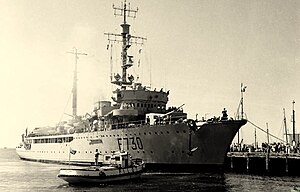Italian sloop Eritrea
 Francis Garnier
| |
| History | |
|---|---|
| Name | Eritrea |
| Ordered | 8 May 1935 |
| Launched | 28 September 1936 |
| Completed | 10 February 1937 |
| Fate | Transferred to France 1948 |
| Name | Francis Garnier |
| Namesake | Francis Garnier |
| Acquired | 12 February 1948 |
| Stricken | 1966 |
| Fate | Sunk as target ship 1966 |
| General characteristics | |
| Type | Colonial ship |
| Displacement |
|
| Length | 96.9 m (317 ft 11 in) |
| Beam | 13.3 m (43 ft 8 in) |
| Draught | 4.7 m (15 ft 5 in) |
| Propulsion | 2-shaft diesel-electric, 7,800 hp diesel, 1,300 hp electric motors |
| Speed | 20 knots (23 mph; 37 km/h) |
| Range | 6,950 nmi (12,870 km) |
| Complement | 234 |
| Armament |
|
| Armour |
|
Eritrea was a colonial ship of the Italian
Design
The Eritrea (2,170 tons displacement) was constructed for duties as a typical "colonial ship" and was sometimes referred to as a "
She was armed with four
A modified sister ship to be called Etiopia was planned, but cancelled on the outbreak of war.
Service

Following
In February 1941, as the
She sailed across the
In December 1941, after the official declaration of war, the Japanese government allowed Eritrea to provide assistance to "transport submarines." These submarines, carrying rare goods, arrived in Japanese-held Penang and Singapore from the distant bases in German-held Bordeaux.
On 8 September 1943, when
French service
After the war, Eritrea was turned over to France. The French Navy used Eritrea in colonial service with the name Francis Garnier until 1965. Francis Garnier was then declassed to become a target ship. She was sunk during a nuclear test in the Pacific Ocean in 1966.
See also
- East African Campaign
Notes
- ^ Photo of the "Eritrea"
- ^ "Eritrea" in the Far East
- ISBN 0-87021-459-4.
- ^ History of the "Eritrea" (in Italian) Archived 2010-12-10 at the Wayback Machine
- ^ Eritrea dangerous travel to Asia (in Italian) Archived 2002-06-07 at the Wayback Machine
- ^ "Ceylon Navy's Prized Catch". Sunday Times. Retrieved 11 August 2020.
References
- Brescia, Maurizio (2012). Mussolini's Navy: A Reference Guide to the Regina Marina 1930–45. Annapolis, Maryland: Naval Institute Press. ISBN 978-1-59114-544-8.
- Campbell, John (1985). Naval Weapons of World War Two. Annapolis, Maryland: Naval Institute Press. ISBN 0-87021-459-4.
- Cosentino, Michele (2016). "The Colonial Sloop Eritrea". Warship 2007. London: Conway. pp. 30–41. ISBN 978-1-84486-326-6.
- Fraccaroli, Aldo (1968). Italian Warships of World War II. Shepperton, UK: Ian Allan. ISBN 0-7110-0002-6.
- Gardiner, Robert & Chesneau, Roger (1980). Conway's All the World's Fighting Ships 1922–1946. London: Conway Maritime Press. ISBN 0-85177-146-7.
- Gardiner, Robert & Chumbley, Stephen (1995). Conway's All the World's Fighting Ships 1947–1995. Annapolis, Maryland: Naval Institute Press. ISBN 1-55750-132-7.
- ISBN 1-59114-119-2.
